Successful modern app development teams must understand the role each of their members plays in Agile development processes. Collaboration between stakeholders and team members is crucial and how they contribute to a product’s success depends on how well their differences complement each other.
With the rising popularity of mobile products, app development is quickly becoming one of the most sought-after professions in the world. This increase in demand means that app developers now have the work cut out for them, and the competition now is nothing but fierce. However, app development is a very complex process. It involves specific skills, expertise, and abilities, not to mention the long hours and countless sleepless nights it takes to deliver a successful product. So, it’s not to be taken lightly. It is a team sport where if you want to win the game, you must have a group of professionals capable of working together to bring forth efficiency, collaboration, and communication. The best way to do so is to work under a trusted and efficient approach to app development. So, most innovative and relevant development companies have turned to the Agile methodology approach to effectively automate, unify, and improve all app development processes.
For app development companies, taking an Agile approach to app development is a failsafe way to manage projects and optimize development times efficiently. It involves collaboration between teams and promotes continuous improvement at every stage of the development process. However, if you’re working under an Agile methodology, you must understand that your employees must have their roles within the workflow very clear so they can effectively contribute to the product’s overall success. The importance of differentiating between these roles comes to light in the Agile methodology with the introduction of two key roles: Scrum Master and Product Owner. Unfortunately, these two very different roles are often confused and used interchangeably, leading to hurdles in the development process and miscommunication incidents that can hamper the development of any digital product.
At Foonkey Monkey, we decided to highlight the critical differences between the Scrum Master and the Product Owner to help you avoid costly mistakes and misunderstandings. But before we go any further, let’s touch on what Agile is all about to establish some context.

What is Agile development?
The Agile approach is a set of development methodologies that center around ensuring constant collaboration between team members and stakeholders to enforce continuous improvement during the development process. Furthermore, agile is based on the principle of iterative development, where a product’s requirements and wholesomeness revolve around cross-functional development teams that work in tandem to accomplish all goals and the product’s value proposition as effectively and efficiently as possible. As a result, ideal Agile teams are self-sufficient, self-organizing, and disciplined enough to guarantee practical teamwork and promote a disciplined project management process.
Agile can be adapted to countless work environments and industries, from construction to engineering. It is becoming so popular that even industries like marketing and design are starting to reap its benefits. When it comes to mobile app development and the development industry, Agile has been at the crux of the most successful, most efficient companies in our industry and is behind the scenes of the most popular mobile and software products out there. In fact, Agile’s adoption has grown so much that over 71% of development companies are now working under the Agile methodology, reporting a mere 9% failure rate. Additionally, studies have shown that Agile teams are 25% more successful thanks to them having the capacity to deliver software faster, be more productive, have a better ability to manage priorities, and produce higher quality IT products. And, since Agile focuses on iterative and adaptive development, increasing customer engagement, and responsive risk management, Agile products align perfectly with clients’ requirements and user expectations.
But you may be wondering: where did it all start? The Agile methodology comes from the methods, practices, and 12 principles expressed in the Agile Software Development Manifesto written in 2001 by 17 independent developers. They created the Agile Manifesto based on their experience of which elements, workflows, and approaches work and which don’t work in software development. Since its inception, and thanks to its universality, the original Agile Manifesto has been implemented by industries and enterprises as disparate as marketing professionals, architects, and Boy Scout troops.
And thanks to its complexity and variety of applications, its authors lined out different frameworks developers can use: Scrum, Extreme Programming (XP), Feature-Driven Development (FDD), and Kanban. However, for this article’s purpose, and because we’ve worked with it for years and understand it better than no one, we’ll only dig into what Scrum is and its scope within the Agile approach. Let’s see.

What is Scrum?
As mentioned above, Scrum is an Agile methodology framework based on principles and values that enforce iterative and progressive development, ideally resulting in the delivery and sustainability of robust software and mobile products. Scrum aims to ensure that cross-functional development teams work together seamlessly to deliver the latest versions of digital products continually and in short cycles. Each of these teams has all the necessary knowledge and skills to build and develop pieces of functionality from idea to delivery, focusing on promoting the visibility of the entire development progress. In that sense, Scrum teams work under a dynamic agenda to bring a product to life with transparency, constant inspection, collective accountability and responsibility, and continuous adaptation. As a result, Scrum supports fast feedback, innovation, rapid product adaptation, continuous improvement, and a higher customer satisfaction rate.
Much like a rugby team–which inspired its name–Scrum encourages development teams to work in tandem to learn, organize, analyze, communicate, and account for all the parts of the development process. And, unlike other development methodologies where developers build a product in one operation, Scrum breaks down projects into pieces, delivering several iterations of one product to ship and promote high business value in little time. These pieces or “chunks” are referred to as sprints, and they make up Scrum iterations, usually consisting of two to four-week sprints.
Sprints usually require a planning meeting at the start of each sprint so team members can establish tasks and realistic commitments to create a sprint backlog or a list of the functions pertaining to that specific sprint. The team also creates a product backlog, usually written using user stories, which determines the features and functionality that must be added to the product to improve it. Afterward, and for the sprint’s duration, meetings are conducted daily to ensure the project remains on track and to promote accountability, responsibility, and teamwork. Finally, at the end of each sprint, teams have a retrospective where they reflect on how the sprint ended, what they accomplished, and what opportunities for improvement are left. The goal of each sprint is to provide a complete variation of the final product that includes the most crucial features and can be delivered to the client at any time they request it. In that sense, if and when more features are needed, Scrum development teams can build them in subsequent sprints, include them in the product, and adapt them per the client’s requests and user feedback.
Scrum teams are self-organizing and usually don’t require a governing presence that directs and bosses. However, they are generally supported by three specific roles: The Scrum Master, the Product Owner, and the team itself. The latter is pretty straightforward and refers to the group of developers that work on a particular project. A Scrum team usually consists of no more than nine people with design, business, and development skills who work together and are jointly responsible for the product’s delivery and meeting each sprint’s goals. However, the Scrum Master and Product Owner’s roles are another story. Both of these team members work closely together, and both play pivotal roles in the success of a Scrum project. Still, these two roles differ significantly, and understanding these differences can determine a project’s success or failure, which, you guessed it, is what we’re diving into right now.
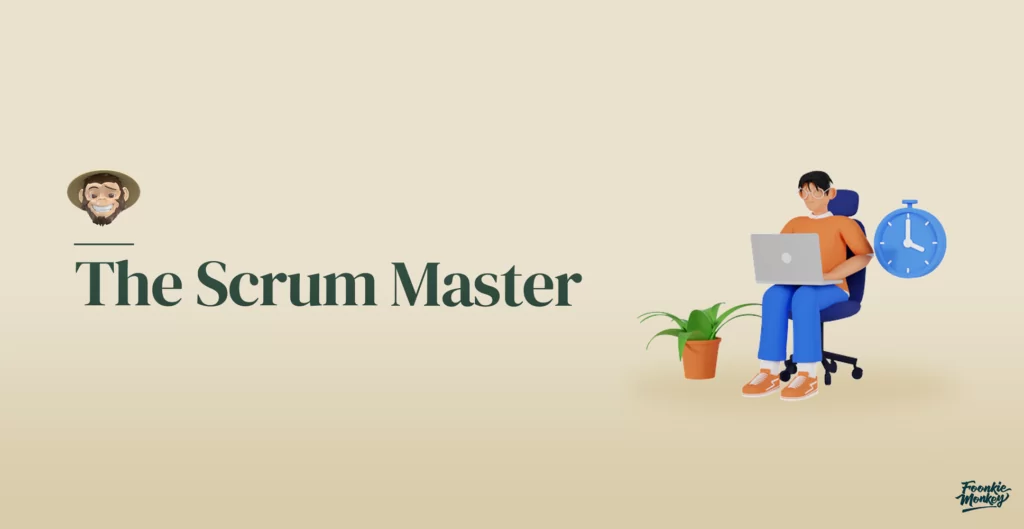
The Scrum Master
The job title is pretty self-explanatory: the Scrum Master is the master of Scrum. Their primary responsibility is ensuring the team adheres to and follows the Scrum framework and abides by all the elements that it shelters. As we already learned, Scrum has a particular set of roles, terms, components, and rituals that Agile development teams must follow. In addition, the Scrum Master works with each development team member to coach them and help them navigate the Scrum framework. In that sense, the Scrum Master is accountable for the team’s effectiveness. On their shoulders lies how well the team understands Scrum’s requirements and how well they apply that theory to practice. Still, while a good Scrum Master is the gatekeeper for the Scrum framework, they can also remain flexible and seize all opportunities for their team to learn and improve.

The Product Owner
The Product Owner is responsible for ensuring the development team always delivers high-value products. They specialize in streamlining priorities by defining user stories and ensuring they meet the users’ needs while creating, managing, and prioritizing the product backlog. The Product Owner is also an expert at supporting the integrity of the product’s features and functionality by guiding the development team to meticulously discuss and analyze decisions and implementations to ensure they align with the company’s and the client’s goals. They also help guide the team in establishing a list of priorities and most important features to avoid unclear direction and conflicting priorities that can impact the relationship between the company and the client.
Additionally, the Product Owner is the company’s face to the client. They represent both the client and the development team, acting as a bridge between both sides to help convey the requirements and features the team must include in the following product release. They also communicate with all business-side parties to paint a clear picture of the priorities, needs, business processes, and the most central customer-oriented values. In that sense, the Product Owner must know and understand the client and their needs and balance them with the needs of the team and other stakeholders in the company. This balance must result in a clear product goal to develop a vision of the value the development team must deliver to the client.
So, what’s the difference?
As we said, and as you can see, both roles play a pivotal part in the entireness of the Scrum framework. Nonetheless, the two have critical differences, and the importance of establishing those differences goes beyond simple theoretical differentiation. If confused, misused, or interchanged, the consequences for the functioning of the entire Scrum development can be dire. They can create confusion, misdirection, and misalignments within the system and fragment it.
So, to help you avoid any misunderstandings, here are the main differences between Scrum Master and Product Owner.
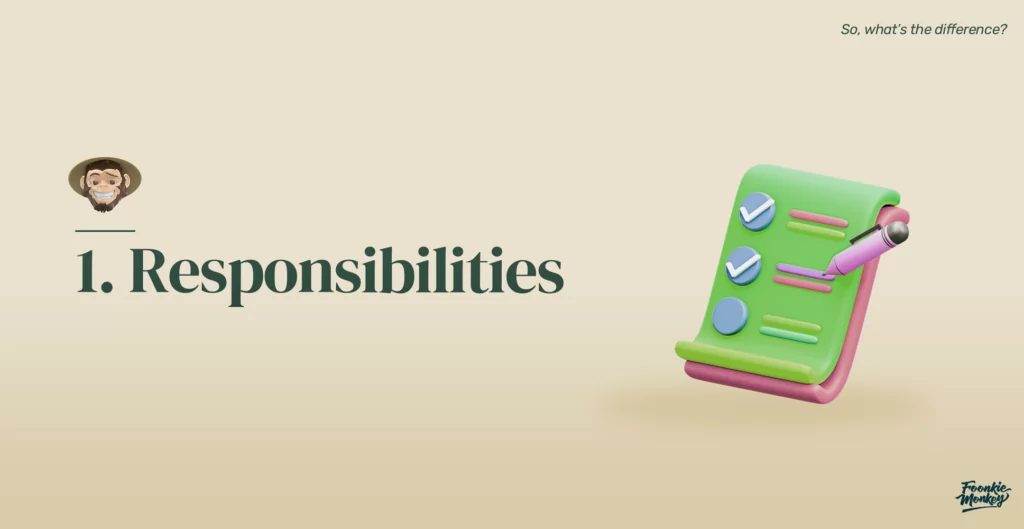
1. Responsibilities
Scrum Master
Coaching: The Scrum Master is the team’s coach, plain and simple. They are responsible for ensuring the execution and alignment of all Scrum principles, practices, and values. They guide the Scrum team in following all these principles and take all the necessary measures to ensure optimal performance under the Scrum guidelines. The Scrum Master can do 1-on-1 coaching sessions or team sessions where they address weak spots, concerns, doubts, or any issues the team may have to empower them to remain self-organized and self-managed.
Facilitating Scrum events: The Scrum Master facilitates daily Scrum and standup meetings, manages sprint planning, reviews, and retrospective, and ensures these activities are always productive and priority-oriented.
Remove impediments: The Scrum Master stays on top of any roadblocks that may hinder the correct flow of the development process. They help the team eliminate these roadblocks and manage them via workflow improvements.
Ensure the team’s workflow: When the Scrum team isn’t blooming, the Scrum Master must pinpoint the reason and fix it, whether it is because of slow computers, thermostat problems, poor communication skills, or conflictive members. A good Scrum Master doesn’t shy away from going above and beyond to help their team, even if that means making jokes or even getting coffee and snacks for everyone.
Product Owner
Ensure customer satisfaction: The Product Owner ensures that the client’s requirements are always prioritized. They need to maintain constant communication with all external stakeholders and convey their needs to the Scrum team to make sure there is always transparency between all parties. This way, the development process remains relevant and always delivers the highest value.
Product backlog: The Product Owner is responsible for building, editing, managing, and maintaining the product backlog according to the client’s needs and requirements. They are also responsible for user stories, epics, and other elements that help give the team direction regarding the customer’s vision.
Product vision: The Product Owner must translate the client’s vision to the development team and work closely with the Scrum Master to ensure the product’s development aligns with that vision. If the client’s goals and requirements change, the Product Owner must communicate those changes to the team.

2. Skills
Scrum Master
Communication: The Scrum Master’s role centers around good communication skills. They must communicate daily with their team, stakeholders, the Product Owner, and many other external parties; hence, they must possess flawless listening and communication skills to properly convey the project’s requirements, ideas, plans, and modifications.
Leadership: The Scrum Master is the leader of a cross-functional development team, meaning they must own the leadership skills that allow them to bridge any gaps between the team and the client. They must also act as coaches and teachers of their squad, imparting their knowledge about Scrum skills and principles. Additionally, they must take the necessary actions to keep their team happy and guide them to ensure they successfully complete all projects.
Knowledgeable: The Scrum Master must possess the necessary knowledge, both in project management and in Scrum, to address and solve any technical or theoretical issues that may arise.
Soft skills: As a pack leader, the Scrum Master must have excellent interpersonal skills. They should be an excellent communicator and must have significant empathy towards all stakeholders and team members.
Product Owner
User understanding: The Product Owner must have deep knowledge of the product’s users and market. Knowing who the product’s users are, how they behave, their needs, and their behavior is key to developing a vision from the end user’s point of view, a crucial skill for a Product Owner.
Knowledge: The Product Owner must have a clear understanding of the product’s specifications, roadmap, technical aspects, release management, and backlog. They must also be very well versed in sprint planning, review, and retrospectives and must understand all the ins and outs of the Scrum methodology.
Communication: The Product Owner must act as the bridge between all stakeholders and the team, meaning they must have outstanding communication skills. They must also listen to all parties to ensure all the development phases go as planned and can be adjusted as modifications arise.
Good judgment: The Product Owner must understand the needs and requirements of all the stakeholders and their team and make them compatible so everyone can work together. As a result, they must be adept at conflict resolution and have to be able to make the right judgment calls, especially when developing the product backlog.
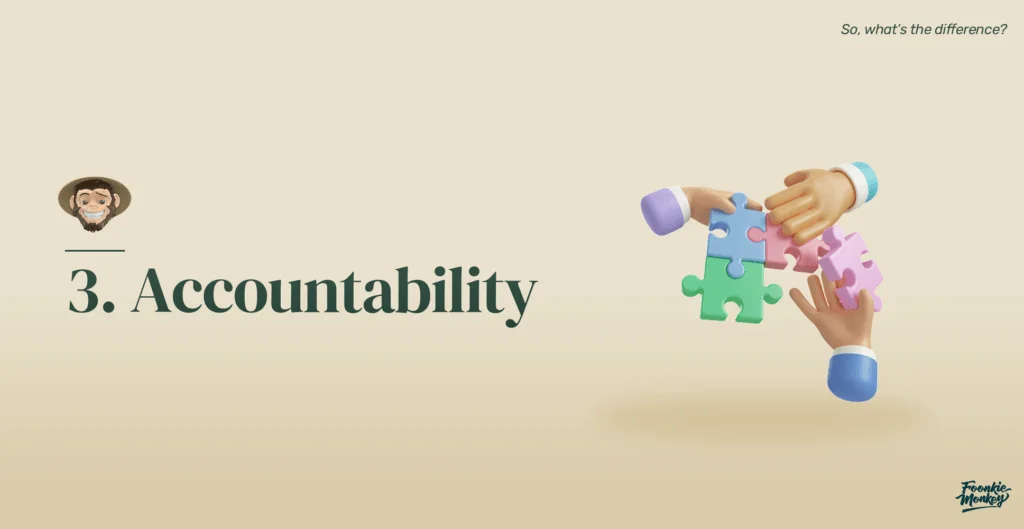
3. Accountability
Scrum Master
The Scrum Master is accountable for helping the team follow the Scrum methodology, leading to the entire project’s success and timely completion. Additionally, the quality of the project and the reporting and communication of the project’s progress to the Product Owner also fall under the Scrum Master’s accountability.
Product Owner
The Product Owner is accountable for creating and managing the product backlog, leading to the entire project’s successful completion. Moreover, they must be held accountable for communicating the project’s progress and updates to the client and other stakeholders outside the team and the company.

Are both roles necessary for a successful project?
The short answer is yes. As you already learned in this article, both the Scrum Master and Product Owner have different yet essential responsibilities and play crucial roles in the Agile universe. And while there’s no set rule that states all development teams MUST have a Scrum Master and a Project Owner, our experience tells us that having them can significantly improve the outcome of a project and the product quality. On the one hand, some Agile companies tend to think that having a Scrum Master is not necessary since the team already understands the ins and outs of Scrum and is aware of how it works and how to do it. So, what’s the point? Let’s save some bucks and not hire a Scrum Master, right? Hmmm…not quite.
The truth is that while most Agile development teams are self-organizing, self-governing, and cross-functional, they still need the direction and coaching that only a Scrum Master can give. Some “Scrum Master-less” teams actually complain that they lack goal-oriented development methods and cannot focus on building iteratively. They also often fight and disagree on crucial matters with no one to help them navigate and fix such conflicts. Additionally, without a Scrum Master, there’s a more significant risk of constant interruptions, delays, and a lack of communication with the Project Owner, which will likely lead to a broken relationship with the client and stakeholders. Hence, the role of the Scrum Master is paramount to ensure the team has a clear direction, works flawlessly under the Scrum methodology, and has a constant communication highway with the Product Owner and stakeholders.
On the other hand, the Product Owner drives the product’s vision. They are the ones who communicate the needs of stakeholders to the team and make sure the development strategy aligns with the budget, vision, and intention of both the client and the users. They also act as a bridge between the Scrum Master and the client. Moreover, they know the team and the client perfectly and so have the ability to understand them, their industries, the market, and how their business operates. So they are the only ones who can voice the requirement details and modifications that may occur to the team. Without a Product Owner, the team would lack a liaison with the client’s vision, and the resulting product would have an absence of essence and will be a complete failure.
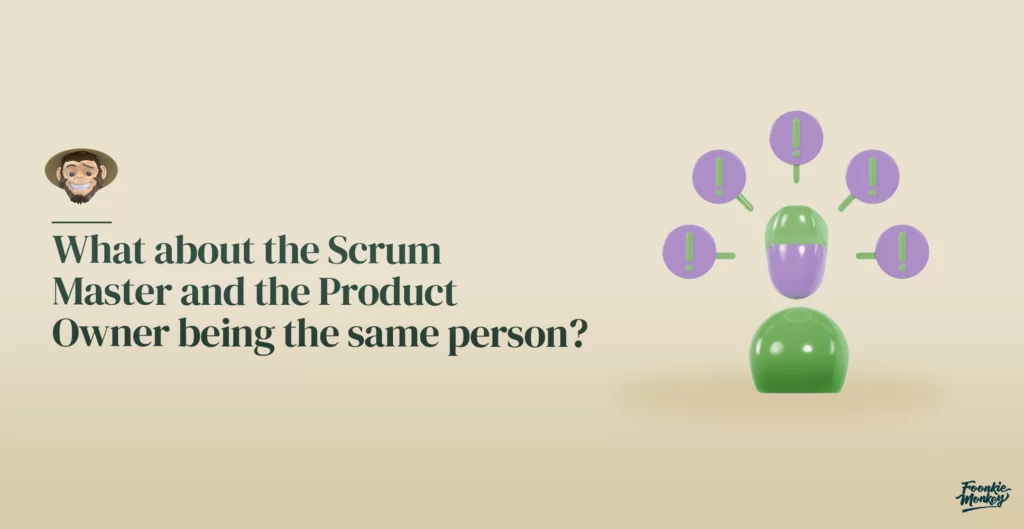
What about the Scrum Master and the Product Owner being the same person?
In short, no, this is not a good idea for a couple of reasons. First, both roles are full-time jobs. So, when a Product Owner acts as a Scrum Master or vice versa, they inevitably take on new, more demanding responsibilities, devaluing their original ones. As a result, there is an increase in the workload, which risks burnout and leaves room for catastrophic mistakes to be made. Merging both jobs in one means that sooner or later, they’ll have to cut corners in crucial tasks such as creating the product backlog, facilitating Scrum events and sprints, and managing the success of the entire development process. Additionally, since they would have too much on their plate, the extra pressure can take their attention away from the product’s vision, and they will have to spend more time focusing on completing tasks and meeting deadlines to avoid problems with the client.
Second, a fundamental conflict of interest between both roles makes it troublesome for a single person to handle such an undertaking. One of the Scrum Master’s primary responsibilities is to support the Product Owner and vice versa. When the Scrum Master and the Product Owner are the same person, that support is non-existent, leaving that employee to fend for themselves and have no support in fulfilling both roles successfully. This lack of support can create focus issues as well. Imagine coaching a team while also solving conflicts, establishing the product’s vision, communicating with the client, meeting with stakeholders, collecting user data, building user stories, and creating the product backlog, all while successfully implementing and enforcing the Scrum methodology. Sounds impossible!
So no, even when you think merging both roles into one sounds more efficient, especially money-wise, the truth is both roles are crucial for a successful Scrum team, and keeping them separate is not only wise but also necessary. You need the outside perspective and support of the Product Owner and the team vision, support, and structure of the Scrum Master. It’s too easy and tempting to cut corners on this aspect of Agile development, so make sure you think twice when making decisions that can impact your product’s success!
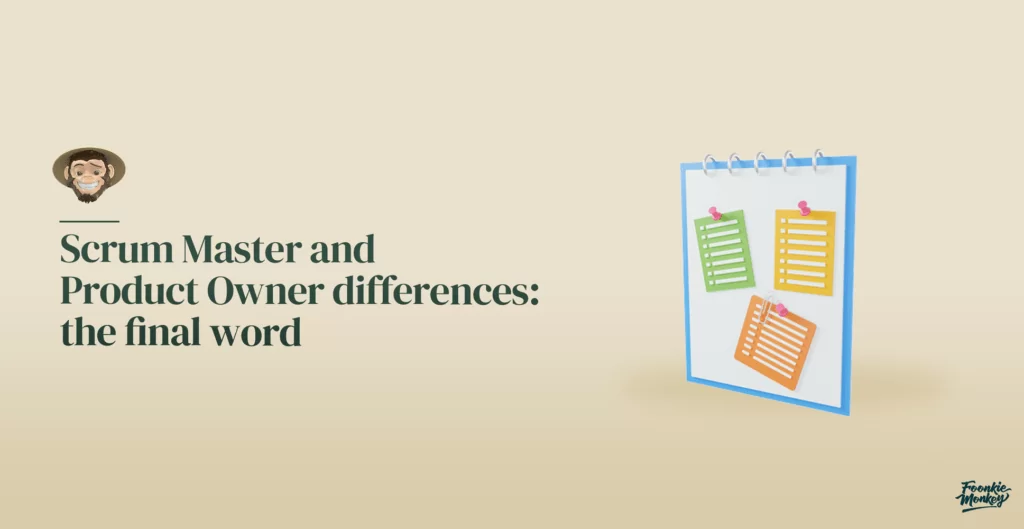
Scrum Master and Product Owner differences: the final word
Both the Product Owner and Scrum Master are both essential roles in the scheme of things for Agile Scrum; there’s no denying that. However, both roles can be easy to mix up and are often used interchangeably, to the point where we’ve seen one replace the other. This confusion can create a lot of turmoil within Agile development teams, resulting in weak, defective products that fail to meet users’ expectations. As a result, and when in doubt, it becomes imperative to compare both roles to understand how different and necessary both of them are. And while the two share similarities, each role is distinct and has unique responsibilities that reflect the nature of each and its importance within the Scrum methodology and the Agile ecosystem.
So, suppose you’re working with an Agile team or are interested in the importance of both these roles. In that case, you must find a company that has both a Scrum Master and a Product Owner and encourages frequent collaboration between them. Also, they must both seek constant product adaptation and enforce a leadership philosophy where each member plays their part while keeping the development team self-organized and accountable. This way, mistakes are significantly reduced, and best practices are set in place to ensure the resulting product is robust, innovative, and always meets both the client’s and the user’s needs.
We at Foonkie have a proven track record of working under Scrum, so if you want to work with us or have any questions or concerns, please contact us. We’re happy to help!
